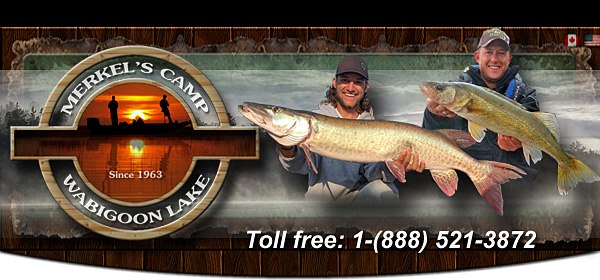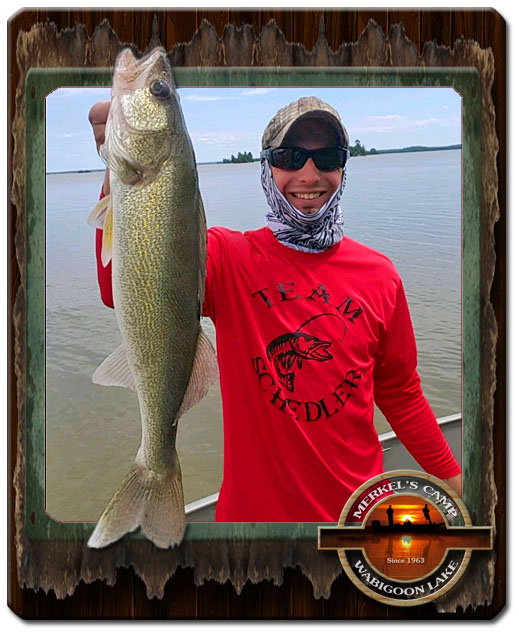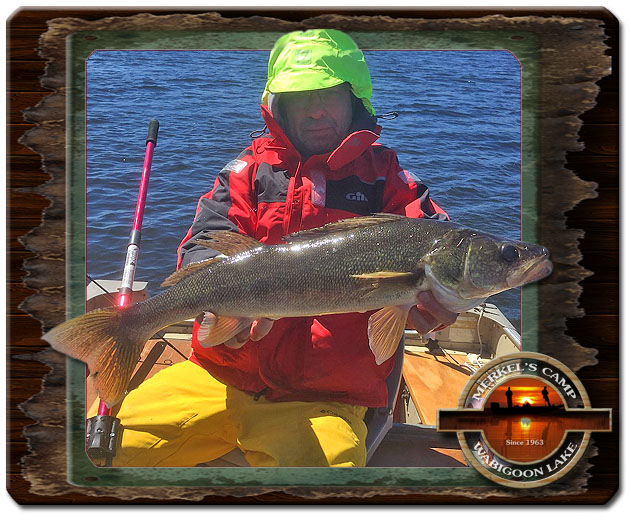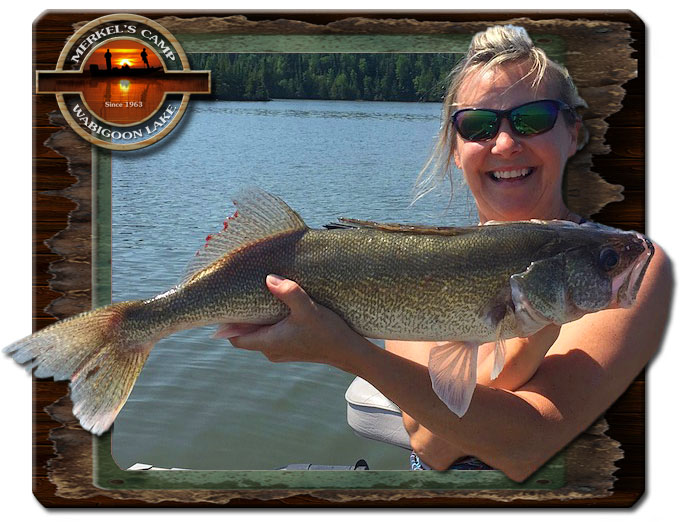



Walleye fishing on Wabigoon Lake, Dinorwic Lake and Little Basket Lake is awesome. After a week of catching Walleye after Walleye our guests are smiling from ear to ear and have the tired arms to prove it!
We are centrally located on the Wabigoon/Dinorwic, Butler chain. We fish 12 inches to 12 feet deep all year long for walleye and a variety of other species. Wabigoon and Dinorwic are both easy lakes to fish because the Walleyes are everywhere and because both lakes are shallow for their size, you don't have to worry about the big Walleyes taking off into deeper water in the summer or when it's sunny. In these lakes Walleyes of all sizes are caught at any time of year. Wabigoon and Dinorwic display many structures including reefs, shoals, islands, feeder streams, sand bars topped with wild rice that slide off into deeper holes and rocky points leading into weedy bays. The Walleyes seem to love all these types of structures so everybody can fish in conditions they are used to and find great success.
Walleye are common in the 1 to 3-pound range with plenty of Walleyes in the 4 to 6 pound range getting caught by our guests during a week of fishing. Wabigoon and Dinorwic are big lakes and many times more nutrient than most northern lakes in Ontario thus not only do the lakes produce massive numbers of Walleyes they produce huge trophy Walleyes. During a week of fishing you have an excellent chance at catching a Walleye between 6 and 10 pounds.
The lakes are on average a depth of 18 feet with a few deeper holes. This helps produce a huge fishing area. Most of the fishing is in 12-foot or less. This is perfect for those who like to cast into shore and can prove very rewarding. Depending on your preference, mid-day is excellent, as is early morning & evening producing plenty of top water action.
Big Walleyes do get caught during the day but there are so many Muskie and Pike in the lake that the really big female Walleyes usually get more active in the evening and stay active into the morning and then hide when the Muskie and Pike start feeding. It takes just as much skill to catch a small fish vs. a big fish. It's really luck of the draw and occasionally guests do catch Walleyes over 10 pounds. Wabigoon and Dinorwic have produced Walleyes over 15 pounds.
How many Walleyes you catch in a day is affected by how hard and how long you fish as well as other factors such as air pressure, knowledge of Walleye fishing, knowledge of the lake and how actively the Muskie and Pike are feeding. When the Pike and Muskie are in a feeding frenzy the Walleyes can slow down a bit. It's not unreasonable to expect to catch between 20 and 40 Walleyes in a day. There maybe slower days and some guests are lucky and come upon a big school of Walleyes and can catch one fish after another. There have been exceptional days where guests have been known to catch over 80 Walleyes in a day. You would need to be at the right place in the right time with the right bait that the Pike, Bass, Perch and Muskie will leave alone. Even if you only catch 20 Walleyes in a day, throwing in 20 Pike, 20 Bass and a couple of Muskie - we'd say you had an awesome day!

We have a remote and private outpost cabin on Little Basket Lake, which is a 40-mile drive northeast from our main camp and into the thick wilderness of Northwestern Ontario.
Between Little and Big Basket there is approximately 11,000 acres of fishing waters! This vacation option is very popular with our guests because they catch tons of Walleyes. You have full access to Little Basket Lake and the bigger Basket Lake and it's stuffed with Walleye, Northern Pike and the occasional Lake Trout.
You can have non-stop action all summer long on Little and Big Basket Lakes. Many of our guests never leave the great Walleye and Northern fishing in Little Basket! Some like to venture a bit farther and travel into Big Basket 2-3 miles. Very few people fish any further. The lake is spring fed and the walleyes are frequently caught in shallow water. There is plenty of rocky shoreline for the Walleyes and weedy bays for the Northern Pike.
For the size of the lake you will be very surprised at how big the Walleyes get. Like most lakes they are most common in the 2 to 4 pound range but this lake has tons of Walleyes in the 5 to 7 pound range. There are even bigger Walleyes in the lake and some guests do get lucky and catch a big trophy. These lakes are smaller but also receive next to no fishing pressure. As a result the fishing is just as good as the expensive fly-ins in the area. Guests can catch over 50 Walleyes in a day.
This fabulous experience is all possible at our Drive-In Outpost, where weight and weather are NOT an issue!
A fishing trip to Northern Ontario is not complete until you have had a shore-lunch. Walleye taste so much better when cooked over an open fire and the fish is 100% fresh. There are many places along the shore on Wabigoon Lake and Dinorwic Lake where you can relax and cook up a nice shore-lunch.
 When fishing the Wabigoon and Dinorwic Chain of lakes, we've found jigging to be
a very popular and rewarding method. 1/8 oz jigs are the favoured weight as most of the fishing all
season is 10'- 12' feet of less. Keep a good selection in a variety of colours.
Line size and type is a personal choice . You can't go wrong with a good 8-10lb
line.
When fishing the Wabigoon and Dinorwic Chain of lakes, we've found jigging to be
a very popular and rewarding method. 1/8 oz jigs are the favoured weight as most of the fishing all
season is 10'- 12' feet of less. Keep a good selection in a variety of colours.
Line size and type is a personal choice . You can't go wrong with a good 8-10lb
line.
When hooking on your minnow, a great method is to put the hook through the minnows mouth and come out the gill, pushing the hook back as far as the shank of the hook will allow. Rotate the hook to put it up the belly and out the back. This method will save you a lot of minnows and catch you more fish.
For those fish that bite short, your hook will be in the zone. Also the minnow will stay on longer when bouncing along the rocks and weeds. When you get hung up on rocks or weeds, try not to pull your hook out too aggressively. Most times a fish is ready to take your bait as it becomes unsnagged. With a subtle shake of the hook, it will stay in the strike zone as compared to pulling your bait up to 5' away.
Another tip when jigging is to keep your rod tip up and use short jigs. This tends to get caught up less. Remember short jig strokes. Next time you have your rod in your hand, just jig it off the ground. Pay attention to the length of your jig and how much your jig moves. You'll be surprised at the movement.
Leeches and night crawlers work also. We use half a crawler. There will be times when you want to jig aggressively along the drop off or point of a reef. In this case, use a 1/4 oz jig. Larger minnows work well.
Trolling is also a great method. Use a lindy style spinner rig. Some days the colour of the blades makes a huge difference. Using a split clevis will allow you to change the blades quickly. Again, minnows and crawlers work well. There is also a terrific selection of artificial baits that can be used to jigging and trolling. Change your tactic by using a crank bait if things are slow. Many guests spend the day throwing crank baits with great success!